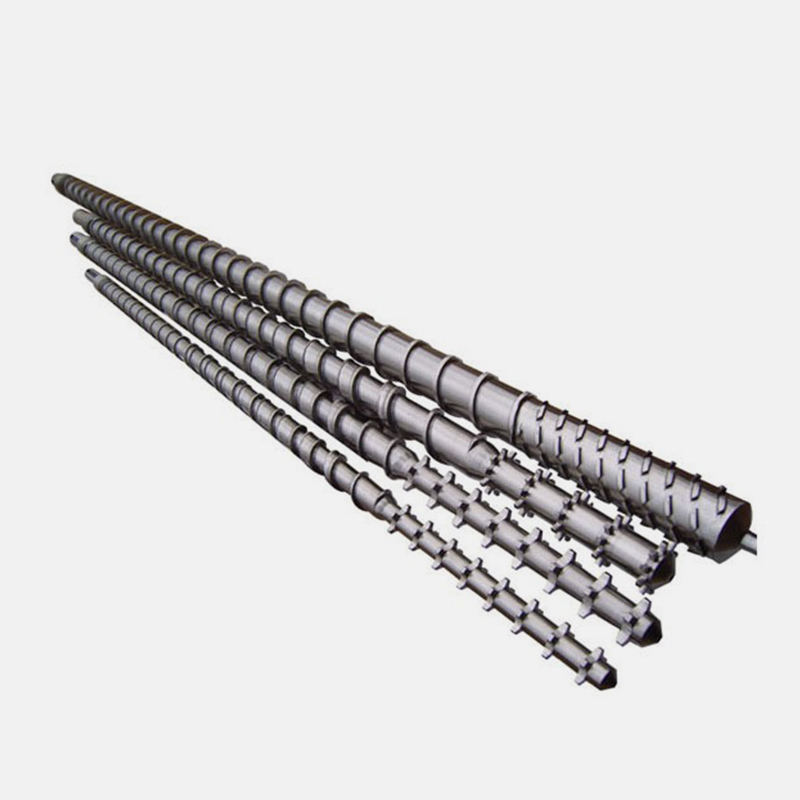When retrofitting or upgrading an existing extruder with a new
Extruder screw barrel, several considerations should be taken into account:
1.Compatibility: Ensure that the new screw barrel is compatible with the existing extruder system. Consider factors such as the mounting configuration, dimensions, and connection type to ensure a proper fit.
2.Material and Application: Evaluate the specific material being processed and the desired extrusion application. Different materials may require specific screw designs or features to optimize performance. Consider the melt characteristics, viscosity, and thermal properties of the material to select a screw barrel that can effectively process it.
3.Screw Design: Assess the screw design options available for the retrofit. Depending on the specific requirements of the application, you may consider different flight depths, pitch, compression ratios, mixing elements, or barrier designs. Consult with a screw manufacturer or extrusion expert to determine the most suitable screw design for the desired results.
4.Output Capacity and Quality: Determine if the desired upgrade is intended to increase the output capacity or improve the quality of the extruded product. The screw barrel selection should align with the desired improvements, considering factors such as screw diameter, length, and the capability to provide better mixing, melting, or cooling characteristics.
5.Process Parameters: Understand the impact of the new screw barrel on the process parameters. Consider adjustments in screw speed, temperature profiles, or residence time to accommodate the characteristics of the new screw barrel. Consult the manufacturer's recommendations or work with an expert to optimize the process parameters for the upgraded system.
6.Installation and Retrofitting: Consider the feasibility and complexity of the retrofit process. Assess whether any modifications or adaptations to the extruder system are required to accommodate the new screw barrel. Ensure that the installation is performed by trained professionals or with guidance from the screw barrel manufacturer to ensure proper alignment and assembly.
7.Cost and Return on Investment: Evaluate the cost-effectiveness of the retrofit or upgrade. Consider the overall benefits and improvements expected from the new screw barrel in terms of increased productivity, improved product quality, energy efficiency, or reduced maintenance. Assess the return on investment and the expected payback period to determine the economic viability of the retrofit.
8.Training and Support: Ensure that appropriate training and support are available for the operation and maintenance of the upgraded extruder system. Familiarize the operators with the new screw barrel and its operating parameters to maximize its potential and troubleshoot any issues effectively.
By considering these factors, you can make an informed decision regarding the retrofitting or upgrading of an existing extruder with a new screw barrel, ultimately enhancing the performance and capabilities of the extrusion process.
Extruder screw barrel for blowing film extruder machine
Material: 38 CrMoAlA(JIS SACM645); 42 CrMo(JIS SCM440)
Depth of nitrogen layer: 0.6~0.8mm
Nitrided Brittleness: above 1 stage
Surface Roughness: Ra0.4 um
Screw straightness: 0.015mm
Hardess of surface chromium-plating after Nitriding: HV≥950HV
Chromium plating Depth: 0.025-0.085mm
Alloy Depth: 2.5mm-4mm
Products Are Processed By The Following Steps:
Hot Treatment
Nitriding Treatment
Electroplating Hard-chrome layer
Hi-frequency Quenching
Spray Coating Bimetallic Layer Of Corrosion And Abrasion Resistant
Vacuum Quenching

 English
English 简体中文
简体中文 España
España عربى
عربى








